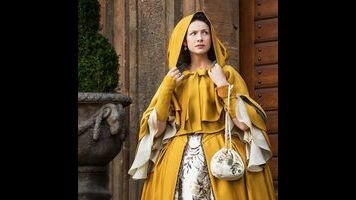Outlander’s not just sexy—it’s important

A lot has been made about Outlander’s steamy love scenes—and for good reason. They’re goddamn sexy, and outrageously, bodice-rippingly so. But Outlander is more than just period-piece smut for book lovers and those with a boner for kilts. And with its second season, the Starz drama is out to prove it.
Like Game Of Thrones, Outlander has a tendency to thrive on big moments. Each of the five episodes available to press prior to this week’s season-two launch had a big reveal in it—and all of those are embargoed until after the individual episodes air. That hamstrings this review a little, but it should keep the spoiler-averse at bay for the time being. (Like Thrones, Outlander is based on a book series, so those who have read Dragonfly In Amber, the second novel about time-traveling nurse Claire Randall, will know at least some of season two’s twists in advance but—and this is important—not all of them.) Some of those reveals are more jaw-dropping than others, but all move the story along in an important way.
After fleeing Scotland, Claire and Jamie Fraser arrive in Paris determined to undermine the future Battle Of Culloden, which Claire—seeing as how she’s from the future and all—knows will undermine the whole highland way of life. Quickly and fortuitously, they fall in with Jamie’s cousin Jared, a wine dealer who’s in convenient need of someone to run his incredibly fancy house in Paris while he zips off to the West Indies. He promises to introduce the Frasers to the heads of the Jacobite movement, thus putting their plan in motion. It all seems almost comically easy, and it is, but then things start to go a bit awry. Old enemies reappear and new ones slither out of the woodwork. As much as Claire and Jamie maneuver to thwart the Scottish revolt, they find themselves almost playing directly into the clumsy, egotistical hands of the daft Bonnie Prince Charlie. And thus the question becomes not just “What happens if you change history?” but rather, “Can history be changed at all?”
While the storylines spark with intrigue and strife, what’s most evident in Outlander’s second season is just how incredibly lush its setting is. With the new season shipped over to pre-revolution Paris, it’s clear the Starz gang has gone for absolute broke with costumes, sets, and CGI. Cityscapes are wide and beautiful, with all of Paris laid out on the screen. There are hundreds, if not thousands, of extras involved at times, all in stunning costumes—and that’s not even mentioning how absolutely breathtaking most of the costuming is for Claire and Jamie. (If the show’s costume designer, Terry Dresbach, doesn’t win an Emmy, a Golden Globe, and a Costume Guild award, it’s a crime.) Even the interior sets are magnificent, with one—Master Raymond’s apothecary—lending itself to so much detail that it’s a shame viewers won’t get to poke about there themselves.
That’s the thing about Outlander: It’s not just well-written and lovely to look at. It’s downright immersive. Despite all its horrific content, the first season must have inspired a thousand trips to Scotland—or at least thousands of purchases of Claire Fraser-inspired knitwear. It’s not so much a show that fans love so much as a show they almost live and breathe. Both through the original text and the adaptation, Outlander inspires incredible amounts of passion, and not just between the dimly lit, writhing characters onscreen. Viewers have come to not just love the show’s drama, but identify with its characters, ’ship its lovers, and feel crippling empathy when its most headstrong characters go through unspeakable tortures. And while season two of the show isn’t quite as horrific—at least through five episodes—it’s still pretty gut-wrenching at points. Time travel and high society have taken its toll on Claire and Jamie, and at times, viewers are left to wonder if the Sassenach and her lover will make it at all. And even if they do—even if their sexy, sexy lives continue on—will everything ever really be okay for a couple of star-crossed lovers born 200 years apart? That’s the mark of a good serial drama, though: not just the anticipation for each new episode, but the feeling that what you’ve already watched bears some sort of weight in the real world. Outlander feels important—even moreso in its second season.